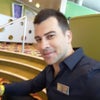Saint Isaac's Cathedral or Isaakievskiy Sobor (русский. Исаа́киевский Собо́р) in Saint Petersburg, Russia is the largest cathedral (sobor) in the city and was the largest church in Russia when it was built (101.5 meters high). It is dedicated to Saint Isaac of Dalmatia, a patron saint of Peter the Great who had been born on the feast day of that saint.
rendering of a Byzantine Greek-cross church.]]
's view of the cathedral and the Bronze Horseman in front of it.]]
The church on St Isaac's Square was ordered by Tsar Alexander I, to replace an earlier Rinaldiesque structure. A specially appointed commission examined several designs, including that of the French-born architect Auguste de Montferrand (1786–1858), who had studied in the atelier of Napoleon's designer, Charles Percier. Monferrand's design was criticised by some members of the commission for the dry and allegedly boring rhythm of its four identical pedimented octastyle porticos. It was also suggested that despite gigantic dimensions, the edifice would look squat and not very impressive. The emperor, who favoured the ponderous Empire style of architecture, had to step in and solve the dispute in Monferrand's favour.
The cathedral took 40 years to construct, under Montferrand's direction, from 1818 to 1858. Under the Soviet government, the building was abandoned, then turned into a museum of atheism. The dove sculpture was removed, and replaced by a Foucault pendulum. During World War II, the dome was painted over in gray to avoid attracting attention from enemy aircraft. With the fall of communism, the museum was removed and regular worship activity has resumed in the cathedral, but only in the left-hand side chapel. The main body of the cathedral is used for services on feast days only.
of the cathedral and Isaac Square.]]
The severe neoclassical exterior expresses a traditional Russian-Byzantine formula: a Greek-cross groundplan with a large central dome and four subsidiary domes. It is similar to Andrea Palladio's Villa La Rotonda, with a full dome on a high drum substituted for the Villa's low central saucer dome. The design of the cathedral in general and the dome in particular later influenced the design of the United States Capitol in Washington, D.C. and the Cathedral in Helsinki.
The exterior, which barely hints at the riotously rich interior, is faced with gray and pink stone, and features a total of 112 red granite columns with Corinthian capitals, each hewn and erected as a single block: 48 at ground level, 24 on the rotunda of the uppermost dome, 8 on each of four side domes, and 2 framing each of four windows. The rotunda is encircled by a walkway accessible to tourists. 24 statues gaze down from the roof, and another 24 from the top of the rotunda.
The cathedral's bronze doors are covered in reliefs, patterned after the celebrated doors of the Battistero di San Giovanni (Florence) in Florence, designed by Lorenzo Ghiberti. Suspended underneath the peak of the dome is a sculpted dove representing the Holy Spirit. Internal features such as columns, pilasters, floor, and statue of Montferrand are composed of multicolored granites and marbles gathered from all parts of Russia. The iconostasis is framed by eight columns of semiprecious stone: six of malachite and two smaller ones of lazurite. The four pediments are also richly sculpted.
The interior was originally decorated with scores of paintings by Carlo Brullo and other great Russian masters of the day. When these paintings began to deteriorate due to the cold, damp conditions inside the cathedral, Montferrand ordered them to be painstakingly reproduced as mosaics, a technique introduced in Russia by Mikhail Lomonosov. This work was never completed.
William Handyside and other engineers used many technological innovations in the construction of the building. The massive portico columns were raised with the use of enormous wooden frameworks before the walls were erected. The dome was gilded by a technique similar to spraypainting; the solution used included toxic mercury, the vapors of which caused the deaths of an unknown number of workers. Over a dozen gilded statues of angels, each six metres high, face each other across the interior of the rotunda. They were constructed using galvanoplastic technology, making them only millimeters thick and very lightweight. St. Isaac's Cathedral represents the first use of this technique in architecture.





